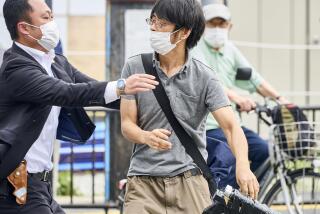Murder Probe by Japan Police Targets Cult
- Share via
TOKYO — Armed with new evidence that may link the religious sect Aum Supreme Truth with last week’s terror attack in Tokyo’s subways, police today formally opened a murder investigation of the secretive cult.
About 1,000 riot police in camouflage uniforms launched another raid today at the Aum complex in the village of Kamikuishiki, 65 miles southwest of Tokyo. They were targeting a secret underground bunker discovered Saturday, a three-story building believed to be the residence of sect leader Shoko Asahara and a previously examined warehouse.
While earlier searches of sect facilities were justified as part of kidnaping investigations, the search warrant for this morning’s raid was based on “suspicion of preparation to commit murder,” police said.
Chemical residues from the subway attack, which killed 10 and injured more than 5,000, have been determined by police investigators to show characteristics identical to those of residues found near an Aum facility after residents complained of a foul odor last July, Kyodo News Service reported.
The residues also match traces left from a poison gas incident last June that killed seven and injured 200 in the central city of Matsumoto, the report said.
All three cases involved sarin nerve gas, which can be manufactured and handled in various ways that would leave identifiably different residues.
A possible motive for the poison gas attack in Matsumoto was reported Saturday by Japanese media: Among those injured when a deadly cloud of sarin wafted through a residential neighborhood were three judges due to rule on a land dispute involving the Aum sect.
The incident resulted in postponement of the judges’ ruling in the case, which had been due shortly. The judgment still has not been made, and the sect remains in possession of the disputed land.
Police also stepped up their search for Asahara, 40, who went into hiding after Monday’s attack. The National Police Agency has asked Japan’s 47 prefectural police authorities for assistance in locating Asahara. Although a warrant has not been issued for his arrest, police said they wish to question him about why so many toxic chemicals were found at sect facilities.
In a videotape sent to television stations, Asahara denied that the sect had anything to do with the subway terrorism.
Police continued Saturday to gather clues in the case. Five bags used in the attack were made of a rare industrial plastic, which may lead to the perpetrators, police said.
The atmosphere on Tokyo subways and commuter trains remained tense Saturday, with white-helmeted employees patrolling the cars in search of suspicious people or objects, while loudspeakers warned people not to leave anything behind or touch strange items. Sales of soft drinks were also suspended at some commuter railway stations, apparently out of fear that a spilled drink might set off panic.
The Tokyo police department has stationed uniformed and plainclothes officers at train stations, concert halls and stadiums as security measures against a possible new terror attack, the U.S. Embassy said in a statement Saturday. The embassy urged individuals to maintain “increased security awareness.”
The embassy said police are investigating anonymous threats of further toxic gas attacks, and noted that police have urged department stores, universities and office buildings to strengthen private security patrols.
At the sect’s complex in Kamikuishiki, about 400 police equipped with chemical warfare protective gear Saturday confiscated barrels marked “phosphorus trichloride” and “poison.” Phosphorus trichloride is a key ingredient for the manufacture of sarin.
Police planned to use power shovels and excavators today to drill holes through concrete to examine the bunker, Kyodo News Service reported. The secret bunker discovered at Kamikuishiki might be an underground warehouse or a place to confine followers.
“(The sect) routinely gave followers injections there,” the agency quoted an unnamed follower as saying. “They were handcuffed and placed in the underground bunker, which looks like a solitary confinement cell.”
In the mountain-ringed city of Matsumoto, Michio Yamauchi, lawyer for the original landowner involved in the court dispute with Aum, blasted the sect in a news conference Saturday.
“We’ve been saying all along that this is a case of fraud,” Yamauchi said. “If there had been no Matsumoto (poison gas) incident, the court would have announced a certain conclusion. As you know, there was a sarin incident. All three judges were victims, and the judgment was postponed.”
Asahi Television, in a report Saturday on the Matsumoto sarin incident, said that the toxic gas was released upwind and adjacent to a residential compound for judges. Had the wind direction been only slightly different, the three judges’ residences would have been in an even more direct path of the deadly fumes, it said.
Kyle Olson, an expert at the Chemical and Biological Arms Control Institute in Alexandria, Va., who investigated the Matsumoto incident and is now in Tokyo to look into the subway terror poisonings, said in an Asahi Television interview that it is only logical that both incidents were perpetrated by the same organization.
“I don’t think it is likely that two groups would have decided to develop sarin as a weapon of terror so quickly in time, nor that having developed that weapon they would use the same basic policy of striking and then not taking any responsibility for the attack,” Olson said. “These are the elements that to me suggest that it was the same group.”
More to Read
Sign up for Essential California
The most important California stories and recommendations in your inbox every morning.
You may occasionally receive promotional content from the Los Angeles Times.













